New York City's Sinking Issue Due to Skyscrapers and Rising Sea Levels
Core Concepts
The author argues that the weight of New York City's skyscrapers, combined with rising sea levels, is causing the city to sink. The main thesis is that coastal cities worldwide are facing similar challenges due to urbanization and climate change.
Abstract
New York City's sinking issue is attributed to the massive weight of its buildings and rising sea levels. The ground beneath the city is subsiding by 1-2mm per year, posing significant problems for a coastal city. Other global cities like Jakarta and Manila are experiencing even faster rates of subsidence, leading to infrastructure damage and frequent flooding. Various solutions such as constructing flood defenses, slowing groundwater extraction, and innovative urban planning strategies are being considered to address this pressing issue.
New York's skyscrapers are causing it to sink – what can be done about it?
Stats
New York City sits on 762 million tonnes (1.68 trillion pounds) of concrete, glass, and steel.
The relative sea level rise in New York is 3-4mm (0.12-0.16in) per year.
Mexico City is sinking at a rate of 50cm (20in) per year.
Quotes
"As the human built environment continues to grow, it adds pressure to the soil and bedrock below that can lead to subsidence."
"If they don't want to have massive loss of infrastructure and economic capacity in a few decades, they need to start planning right now."
Key Insights Distilled From
by at www.bbc.com 05-23-2023
https://www.bbc.com/future/article/20230523-new-yorks-skyscrapers-are-causing-it-to-sink-what-can-be-done-about-it
Deeper Inquiries
How can coastal cities balance urban development with sustainability?
Coastal cities can balance urban development with sustainability by implementing smart growth strategies that prioritize compact, mixed-use developments to reduce the need for extensive infrastructure and transportation networks. They can also promote green building practices, such as using sustainable materials and energy-efficient designs, to minimize the environmental impact of new constructions. Additionally, preserving natural habitats like wetlands and mangroves can help mitigate flooding risks while providing valuable ecosystems services.
What are potential drawbacks or unintended consequences of implementing flood defense strategies?
One potential drawback of flood defense strategies is the false sense of security they may provide, leading to complacency among residents and policymakers. In some cases, hard engineering solutions like seawalls and dykes can disrupt natural coastal processes, causing erosion in adjacent areas or altering habitats for marine life. Moreover, these structures are costly to build and maintain over time, putting a strain on municipal budgets.
How can innovative solutions like floating cities contribute to addressing coastal subsidence issues?
Innovative solutions like floating cities offer a novel approach to addressing coastal subsidence issues by adapting to rising sea levels rather than trying to prevent them entirely. By constructing habitable structures that rise and fall with the water level, floating cities can bypass traditional land-based sinking problems associated with urban development. These projects also have the potential to incorporate sustainable technologies such as renewable energy sources and efficient waste management systems into their design, setting a new standard for environmentally conscious living in vulnerable coastal areas.
0
